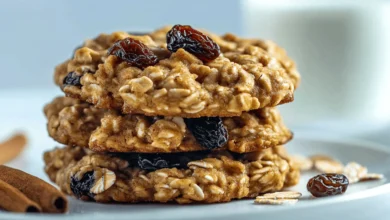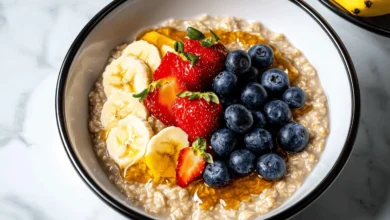
Protein Muffins Recipes
Fluffy, filling, and fantastically nutritious, Protein Muffins have revolutionized the way we think about on-the-go nutrition. Imagine biting into a tender, moist muffin and knowing that you’re fueling your body with high-quality protein instead of empty calories. These portable powerhouses deliver the satisfying texture of traditional muffins while packing a serious nutritional punch. Did you know that a single protein muffin can contain up to 15 grams of protein? That’s equivalent to about two eggs or a small chicken breast, but in a convenient, grab-and-go format! What makes Protein Muffins truly special is their incredible versatility. They work beautifully as a quick breakfast, post-workout recovery snack, or afternoon energy boost. The basic recipe takes just 15 minutes to prep and 12 minutes to bake, making them accessible even on your busiest days. While my Overnight Oats recipe has been a breakfast favorite on the blog for its convenience, these Protein Muffins offer that same ease with the added benefit of being warm, comforting, and customizable in countless ways. Ready to transform your snack game with these nutritional superstars? Let’s explore ten delicious variations that prove healthy eating can be both convenient and crave-worthy!
Table of Contents
What is Protein Muffins?
Ever wondered what happens when the health conscious world collides with America’s love affair with baked goods? The result is the aptly named Protein Muffin! Think of it as the superhero version of your regular muffin cape optional, but protein content mandatory. These aren’t just ordinary muffins that happened to stumble into some protein powder. No, they’re strategically crafted treats designed to fuel your body while satisfying that baked-good craving that hits around 3 PM (or 9 AM… or midnight we don’t judge). As the old saying goes, “the way to anyone’s heart is through their stomach,” but Protein Muffins take it a step further by winning over your muscles and metabolism too! They’re like the overachievers of the baking world tasty enough to feel indulgent but nutritious enough to justify eating two. Ready to become the person who casually mentions, “Oh, these? Just some protein muffins I whipped up”? Let’s get baking!
Why You’ll Love This Protein Muffins:
These Protein Muffins will revolutionize your snack game with their perfect balance of nutrition, convenience, and flavor. First and foremost, the nutritional profile is truly impressive. Unlike regular muffins that often deliver empty calories and a subsequent energy crash, each of these protein-packed gems offers 10-15 grams of complete protein, ensuring steady energy and enhanced muscle recovery. The texture strikes that elusive balance tender and moist like a traditional muffin, yet satisfyingly dense in a way that signals to your brain that you’ve eaten something substantial. One muffin can keep hunger at bay for hours, making them perfect for busy days.
The economic advantage is undeniable. Store-bought protein snacks can cost $3-5 each, putting a serious dent in your budget if you’re consuming them regularly. These homemade Protein Muffins cost approximately $0.75-$1.00 per muffin, depending on your choice of add-ins. That’s potentially $100+ saved monthly for a family regularly consuming protein snacks! Plus, by making them at home, you control exactly what goes into them, eliminating the artificial preservatives and excessive sugars found in many commercial options.

What truly sets these muffins apart is their incredible versatility. The base recipe serves as a blank canvas for endless flavor combinations. Whether you prefer the classic comfort of chocolate chip, the sophisticated profile of lemon blueberry, or the decadent experience of peanut butter chocolate swirl, there’s a variation to satisfy every craving. Unlike my popular Protein Pancakes recipe which requires morning preparation, these muffins can be made once and enjoyed throughout the week. Ready to transform your meal prep routine with these customizable protein powerhouses? Let’s dive into the various ways you can make these muffins your own!
How to Make Protein Muffins:
Quick Overview
These Protein Muffins deliver the perfect trinity of nutrition, taste, and convenience. What makes them truly special is how they transform simple, wholesome ingredients into bakery-quality treats without the sugar crash. The base recipe has a subtle vanilla flavor that pairs beautifully with any mix-ins you choose, while the texture strikes the perfect balance between fluffy and satisfyingly dense. From start to finish, you’ll spend just 15 minutes on preparation and 12 minutes on baking time, meaning delicious, protein-packed snacks can be yours in under 30 minutes. Even better, these muffins stay fresh for days and freeze beautifully, making them perfect for meal prep and busy lifestyles.
What to Serve Protein Muffins With:
Protein Muffins can transform from simple snack to satisfying meal with thoughtful pairings that complement their nutritional profile. For breakfast, serve a warm muffin alongside Greek yogurt topped with fresh berries and a drizzle of honey. The creamy yogurt provides additional protein while the berries offer antioxidants and natural sweetness. This combination creates a complete meal with balanced macronutrients to fuel your morning.
For post-workout recovery, pair a protein muffin with a small banana and a handful of almonds. This combination delivers the perfect ratio of protein for muscle repair, potassium to prevent cramping, and healthy fats for sustained energy. The natural sugars in the banana help replenish glycogen stores while the muffin provides the protein necessary for muscle recovery.
Beverage pairings can enhance both nutrition and enjoyment. A glass of unsweetened almond milk offers complementary nutty notes and additional calcium without excessive calories. For coffee lovers, a muffin alongside cold brew creates an energizing combination that feels indulgent yet remains nutritionally sound. Tea drinkers might enjoy green tea with lemon, which provides antioxidants and helps with the absorption of non-heme iron from plant-based ingredients in the muffins.
For an afternoon snack that keeps hunger at bay until dinner, serve half a muffin with a small apple and a cheese stick. This combination provides protein, fiber, and calcium while creating a satisfying snack that balances sweet and savory elements. The fiber from the apple and protein from both the muffin and cheese work together to maintain stable blood sugar levels throughout the afternoon.
Top Tips for Perfecting Protein Muffins:
Creating truly exceptional Protein Muffins requires attention to a few key details that transform good into extraordinary. First and foremost, understanding protein powder behavior is crucial. Different protein powders absorb moisture at varying rates, which dramatically affects your final texture. Whey protein tends to create a drier muffin, while plant-based proteins often yield moister results. If using whey, you may need to add an extra 2-3 tablespoons of applesauce or Greek yogurt to achieve the ideal consistency. The batter should resemble thick cake batter if it’s dry or crumbly, add moisture in small increments until it reaches the proper consistency.
Temperature management significantly impacts texture and rise. All refrigerated ingredients should be brought to room temperature before mixing, as cold ingredients can inhibit the leavening action of baking powder. This is especially important for nut butters, which incorporate more easily at room temperature. When baking, position the muffin tin in the center rack of your oven, as this provides the most even heat distribution and prevents burning.
For ingredient substitutions, maintain the wet-to-dry ratio for consistent results. If replacing nut butter, consider options with similar fat content sunflower seed butter makes an excellent allergen-free alternative, while Greek yogurt with a tablespoon of oil can work in a pinch. When substituting protein powder flavors, adjust additional flavorings accordingly vanilla protein works universally, while chocolate protein pairs best with compatible flavors like banana, mint, or coffee.
Common mistakes to avoid include overmixing and overbaking. Stir just until ingredients are combined; overmixing develops gluten in the flour and creates tough muffins. These protein-rich muffins bake faster than traditional versions, so begin checking for doneness at the 8-minute mark. A skewer should come out with a few moist crumbs rather than completely clean this ensures your muffins remain moist after cooling.
For maximum rise and presentation, fill muffin liners to the 3/4 mark rather than all the way to the top. Allow the muffins to cool in the tin for exactly 5 minutes before transferring to a wire rack any shorter and they may crumble, any longer and condensation can make them soggy. For a professional bakery finish, sprinkle a few reserved mix-ins on top of each muffin before baking.
Storing and Reheating Tips:
Proper storage techniques ensure your Protein Muffins maintain both flavor and texture for maximum enjoyment throughout the week. For room temperature storage, keep completely cooled muffins in an airtight container lined with paper towels (both below and above the muffins) for up to 2 days. The paper towels absorb excess moisture, preventing the dreaded soggy bottom while maintaining freshness. This method works best in cool, dry environments and is ideal if you’ll consume the muffins within 48 hours.
For longer freshness, refrigeration is key. Store cooled muffins in a sealed container in the refrigerator for up to 7 days. Separate layers with parchment paper to prevent sticking and maintain the integrity of any toppings. Before enjoying, allow refrigerated muffins to come to room temperature for 10 minutes, or warm gently in the microwave for 15-20 seconds to restore their just-baked texture and release aromatic compounds that enhance flavor.
Freezing extends shelf life significantly while preserving quality. Wrap completely cooled muffins individually in plastic wrap, then place in a freezer-safe zip-top bag with the air pressed out. Label with the date and variation type, as they maintain optimal quality for up to 3 months. This individual wrapping prevents freezer burn and allows you to thaw exactly what you need without compromising the remaining muffins.

For reheating frozen muffins, you have several options depending on your time constraints. For the best texture, thaw overnight in the refrigerator, then bring to room temperature for 30 minutes before eating. For immediate enjoyment, unwrap a frozen muffin and microwave on 50% power for 30-45 seconds until just warmed through. Alternatively, split the muffin in half and toast lightly for a delightful contrast between crisp exterior and tender interior.
To revive muffins that have dried slightly, try this professional baker’s trick: wrap the muffin in a damp paper towel and microwave for 10 seconds, then let it rest in the warm microwave for another 30 seconds. The gentle steam rejuvenates the texture without making it soggy. For an extra touch of indulgence, slice and toast refrigerated muffins, then spread with a thin layer of nut butter or Greek yogurt for added protein and freshness.
Protein Muffins 10 Ways to Pack More Nutrition
Course: BreakfastCuisine: AmericanDifficulty: Easy8
servings15
minutes12
minutes175
kcalIngredients
2 scoops vanilla protein powder (64-67 grams)
1 teaspoon baking powder
1/2 cup almond flour
1/2 cup peanut butter (or any nut or seed butter)
1 cup unsweetened applesauce
1/2 cup chocolate chips (optional)
Step by Step Instructions:
- Preheat the oven to 180°C/350°F. Line a muffin tin with 8 muffin liners and set aside.
- In a large mixing bowl, add your protein powder, almond flour, and baking powder, and mix well.
- Add your peanut butter and unsweetened applesauce and mix until fully combined. The batter should be thick but smooth.
- If using chocolate chips or other mix-ins from the variations below, fold them through gently.
- Divide the batter amongst the muffin liners, filling each about 3/4 full.
- Bake for 10-12 minutes, or until a skewer comes out mostly clean. If you notice the tops browning too quickly, cover with tinfoil around the 8-minute mark.
- Remove the muffins from the oven and allow them to cool for 5 minutes, before transferring to a wire rack to cool completely.
More Breakfast Recipes
Looking for additional morning meal inspiration? Our Banana Blueberry Oatmeal Muffins offer another nutritious grab-and-go option packed with fruit and whole grains, perfect for busy weekdays. If you prefer a warm, comforting breakfast, our Steel Cut Oats recipe provides endless customization possibilities while delivering slow-release energy to fuel your morning. And for those days when you need something that doubles as breakfast and treat, try our Oatmeal Cookies recipe they’re made with wholesome ingredients that satisfy your sweet tooth while still providing nutritional benefits to start your day right. Each of these recipes follows our commitment to balancing nutrition with delicious flavors that appeal to the whole family.
FAQs About Protein Muffins
Can I use a different protein powder than what’s called for in the recipe?
Absolutely! The type of protein powder you use will affect both flavor and texture, but all varieties can work with proper adjustments. Whey protein tends to absorb more moisture, so you may need to add an additional 2-3 tablespoons of applesauce or Greek yogurt to the batter. Plant-based proteins like pea, hemp, or brown rice typically yield moister muffins and may require 1-2 tablespoons less liquid. Collagen protein creates a slightly denser, more tender texture. Regardless of which protein you choose, look for options with minimal additives and around 20-25g protein per serving for best results. If using an unflavored protein, consider adding 1/2 teaspoon vanilla extract or other flavoring to enhance the taste.
Why did my protein muffins turn out dry and dense?
Dry, dense protein muffins typically result from one of three issues. First, protein powder naturally absorbs more moisture than flour, so accurate measurement is crucial use a digital scale for precision. Second, overbaking is especially problematic with protein-rich batters; start checking for doneness at the 8-minute mark, as these muffins bake faster than traditional versions. A skewer should come out with a few moist crumbs rather than completely clean. Third, overmixing develops gluten and creates tough muffins; stir just until ingredients are combined, embracing a “less is more” approach to mixing. If you’ve experienced dry muffins previously, try adding an extra 2 tablespoons of applesauce, replacing 2 tablespoons of protein powder with additional almond flour, or reducing the baking time by 2 minutes in your next batch.
Can I make these muffins without nuts for allergy concerns?
Yes, these muffins can be made completely nut-free with a few simple substitutions. Replace almond flour with oat flour (certified gluten-free if needed) or a combination of coconut flour and tapioca starch (use 1/4 cup coconut flour plus 1/4 cup tapioca starch). Instead of peanut butter or other nut butters, use sunflower seed butter, tahini, or pumpkin seed butter, which provide similar fat content and binding properties. For a completely seed-free version, substitute 1/2 cup Greek yogurt mixed with 1 tablespoon olive or coconut oil. Be sure to check your protein powder’s ingredient list for potential cross-contamination warnings if allergies are severe. These substitutions maintain the muffins’ structural integrity and nutritional profile while eliminating allergen concerns, making them suitable for school lunches and shared environments.
How many grams of protein are in each muffin?
The protein content per muffin varies based on your specific ingredients, particularly your choice of protein powder and nut butter. Using the base recipe with standard whey protein (25g protein per scoop) and natural peanut butter (7g protein per 2 tablespoons), each muffin contains approximately 12-15 grams of protein. Plant-based variations typically provide 10-13 grams per muffin. For maximum accuracy, calculate the total protein content of your specific ingredients and divide by the number of muffins produced. To increase the protein content further, consider adding 2 tablespoons of unflavored collagen peptides to the dry ingredients (adds approximately 2g protein per muffin) or using a higher-protein nut butter like peanut protein spread. Pair your muffin with Greek yogurt or a glass of milk for a complete protein-rich snack that provides all essential amino acids.
Can I make these muffins ahead of time for meal prep?
These protein muffins are ideal for meal prep and can be prepared in several ways to suit your schedule. For weekly preparation, bake a full batch on Sunday, cool completely, then store in an airtight container in the refrigerator for grabbing throughout the week. They maintain optimal freshness for 5-7 days refrigerated. For longer-term planning, freeze completely cooled muffins individually wrapped in plastic wrap, then stored in a freezer bag for up to 3 months. You can thaw overnight in the refrigerator or quickly in the microwave when needed. To save even more time, prepare the dry ingredients for multiple batches in advance combine protein powder, almond flour, and baking powder in labeled storage bags, then add wet ingredients when ready to bake. This approach reduces active preparation time to just 5 minutes on baking day.
Can I make these muffins vegan?
Yes, these muffins can be easily adapted for a vegan diet without sacrificing texture or flavor. First, ensure you’re using a plant-based protein powder pea, hemp, brown rice, or a blend works wonderfully. Choose a vegan nut or seed butter, such as almond, peanut, or sunflower seed butter. The applesauce already serves as an egg replacement in this recipe, providing moisture and binding properties. For variations calling for honey, substitute equal amounts of maple syrup or agave nectar. When chocolate chips are included, select dairy-free varieties made with cocoa butter rather than milk solids. For the birthday cake variation, use vegan white chocolate chips or simply increase the amount of sprinkles for visual appeal. With these simple substitutions, you’ll create delicious vegan protein muffins that maintain the nutritional benefits and satisfying texture of the original recipe.
How do I prevent my mix-ins from sinking to the bottom of the muffins?
Keeping mix-ins evenly distributed throughout your protein muffins requires a few simple techniques. First, toss heavier ingredients like chocolate chips, nuts, or fresh fruit in 1 teaspoon of additional protein powder or almond flour before folding them into the batter this light coating helps them stay suspended during baking. Second, ensure your batter has the proper consistency; it should be thick enough to hold a spoon upright for a few seconds before slowly falling. If your batter seems too thin, add 1-2 additional tablespoons of almond flour. Third, for particularly heavy mix-ins like diced apples or frozen blueberries, fold them in very gently and minimally at the last moment before scooping. Finally, reserve about 20% of your mix-ins to sprinkle directly on top of each muffin just before baking. This not only ensures even distribution throughout but also creates an attractive presentation that clearly showcases the flavors inside.
Can I reduce the sugar content in these muffins?
The base recipe is already relatively low in added sugars, relying primarily on unsweetened applesauce for moisture and natural sweetness. However, you can further reduce the sugar content through several strategies. Choose a protein powder with minimal or no added sugar many brands offer stevia-sweetened or unsweetened options. For nut butter, select varieties without added sugar, reading labels carefully as many commercial versions contain hidden sweeteners. If using mix-ins like chocolate chips, reduce the quantity by half or substitute with cacao nibs for chocolate flavor without added sugar. For fruit-based variations, using berries or fruits with lower sugar content like raspberries or green apples provides flavor with less natural sugar. Consider adding a 1/4 teaspoon of stevia powder or monk fruit extract if you need additional sweetness without the sugar. These adjustments can reduce the total sugar content by 30-50% while maintaining satisfying flavor.
Why did my muffins sink in the middle after baking?
Sinking in the center typically results from one of several common issues. Most frequently, it’s caused by opening the oven door too early during baking, which interrupts the rising process before the structure has set. Wait until at least 8 minutes into baking before checking doneness. Another common cause is underbaking protein-rich batters need sufficient time to set internally, even if the outside appears done. Insert a toothpick into the center; it should come out with a few moist crumbs but not wet batter. Over-mixing can incorporate too much air that collapses during cooling, so mix just until ingredients are combined. Finally, check that your baking powder is fresh, as its leavening power diminishes over time. For high-altitude bakers, try reducing the baking powder by 1/4 teaspoon and increasing the oven temperature by 25°F to help the muffins set before they over-expand and collapse.
Can children eat these protein muffins?
These protein muffins can be perfectly suitable for children with minor adjustments. The base recipe provides balanced nutrition with healthy fats, moderate protein, and complex carbohydrates all beneficial for growing bodies. However, some protein powders contain ingredients that may not be ideal for younger children, such as certain artificial sweeteners or very high protein concentrations. For kids, consider using a protein powder specifically formulated for children or replace half the protein powder with additional almond flour. Variations with fruit, moderate chocolate, or gentle spices like cinnamon typically appeal to younger palates. Portion size matters too half a muffin may be appropriate for younger children, while older children can enjoy a whole muffin. These make excellent lunchbox additions, after-school snacks, or breakfast options for busy mornings, providing sustained energy for active kids without the sugar crash that comes from conventional treats.
Conclusion
These Protein Muffins represent the perfect intersection of nutrition, convenience, and flavor proving once and for all that healthy eating doesn’t require sacrifice. By mastering the simple base recipe and experimenting with the ten variations we’ve explored, you’ve gained not just a single recipe but an entire framework for creative, protein-rich baking that can adapt to your taste preferences, dietary needs, and whatever ingredients you have on hand.
What makes these muffins truly special is their versatility. Whether you’re fueling up for an intense workout, needing a quick breakfast on a busy morning, or satisfying a sweet craving without derailing your nutrition goals, there’s a protein muffin variation to meet your needs. The balance of macronutrients protein for muscle maintenance, complex carbohydrates for energy, and healthy fats for satiety creates a nutritional profile that supports your active lifestyle.
Remember that these recipes are starting points rather than rigid rules. As you become comfortable with the base recipe, don’t hesitate to create your own signature variations. Perhaps you’ll discover the next great flavor combination that becomes your personal favorite! The beauty of home baking is the ability to adjust and personalize to your exact preferences.
In a world of complicated diet plans and conflicting nutrition advice, these simple, wholesome protein muffins offer a refreshingly straightforward approach to balanced eating. They remind us that nourishing our bodies can be a creative, enjoyable process that results in genuinely delicious food. So preheat that oven, mix up a batch, and discover your favorite way to enjoy these versatile, nutritious treats!





